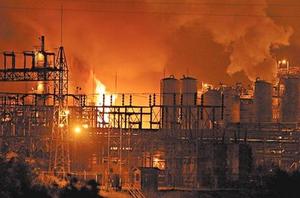Chemical plant safetyDHS initiates first enforcement action of chemical plant safety regulations
DHS initiated its first enforcement actions against U.S. chemical facilities under federal anti-terrorism law; the department sent letters to 18 chemical facilities warning that their failure to comply with safety regulations may result in heavy fines or worse; the administrative orders sent to the facilities represent the final step before the department begins prosecution; under the law, DHS can assess fines of up to $25,000 per day for failure to comply; in addition, the law gives the department authority to shut down a chemical facility if its owners fail to respond to DHS requirements for security improvements; for security reasons, DHS declined to identify the 18 facilities or to indicate the types of sites involved or even where they are generally located

Local officials have frequently been unable to obtain details on chemical plant incidents from company officials, such as during this Bayer CropScience fire in West Virginia in 2009 // Source: wvgazette.com
DHS initiated its first enforcement actions against U.S. chemical facilities under federal anti-terrorism law, warning that they face fines for failing to comply. Department spokesman Chris Ortman said that administrative orders have been sent to eighteen unidentified facilities, warning that they must submit overdue site security plans in compliance with the federal Chemical Facilities Anti-Terrorism Standards (CFATS)
Securityinfowatch’s Joe Kamalick writes that the department also confirmed that all eighteen of the non-compliant sites are in the top tier of facilities considered by federal officials to be most at risk for an attack by terrorists intent on causing massive off-site casualties.
Evan Wolff, a Washington, D.C., attorney whose clients include many firms subject to CFATS regulations, told Kamalick that the department’s initial enforcement moves are evidence that the program is working. “I think it is important to put this in perspective,” Wolff said of the enforcement proceedings against the unidentified eighteen facilities. “When you consider that some 38,000 facilities went through the top-screen process and about 7,000 of those were identified as high-risk sites subject to the regulations, the 18 facing enforcement action represent a very small percentage,” he said.
Wolff, who heads the homeland security practice at Hunton & Williams in Washington, said the relatively small number of operators who have yet to meet department standards for site defenses indicates that the overwhelming majority of operators are in compliance and up to speed.
The CFATS regulations, which came into force in April 2007 (“DHS unveils CFATS-reporting Web site,” 27 April 2007 HSNW), require that certain chemical facilities — those deemed to be at high risk for possible attack by terrorists — must conduct assessments of their security vulnerabilities and submit to the department a formal site security plan designed to remedy shortcomings.
A facility’s site security plan (SSP) must meet standards set by the department, but plant operators may select measures they prefer to satisfy the federal criteria in eighteen areas, such as perimeter control, visitor access, personnel background checks, safeguards against theft or diversion of hazardous materials or in-house sabotage.
DHS spokesman Ortman said the eighteen facilities that have failed to produce security plans have been given several reminders, beginning in late 2009, about their obligations.
Kamalick notes that the administrative orders sent this week represent the final step before the department begins prosecution. Under the law, DHS can assess fines of up to $25,000 per day for failure to comply. In addition, the law gives the department authority to shut down a chemical facility if its owners fail to respond to DHS requirements for security improvements.
As many as 7,000 US chemical facilities — production sites, storage yards, terminals — initially qualified as high-risk sites, but that number has since been reduced to something over 6,000.
In addition to chemical production and storage sites, the high-risk facilities include a broad range of other industrial operations, such as natural gas terminals, electric power utilities, and minerals mining, among others.
Those high-risk facilities are divided into four tiers, based on the degree of risk posed by the volumes and types of chemicals produced or stored and a given site’s proximity to population centers.
For security reasons, DHS declined to identify the 18 facilities or to indicate the types of sites involved or even where they are generally located. The department said the eighteen operators have ten days from the date of receipt to respond to the administrative orders.
Kamalick writes that it remains to be seen whether this opening salvo of federal enforcement actions under CFATS will aggravate or reassure those in Congress seeking tougher regulations.
